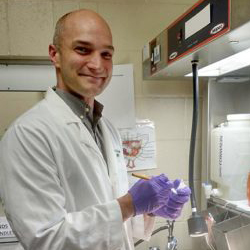 Bay Area Lyme recognizes some of the most promising research projects and scientists in the field of Lyme Disease for its annual Emerging Leader Award. These scientists and project teams come from leading research institutions all over the country and are focused on some of the more innovative approaches to developing new diagnostics and treatments for this insidious disease. The award comes with $100,000 of project funding to help bring their research to the next stage of completion or proof-of-concept.
Bay Area Lyme recognizes some of the most promising research projects and scientists in the field of Lyme Disease for its annual Emerging Leader Award. These scientists and project teams come from leading research institutions all over the country and are focused on some of the more innovative approaches to developing new diagnostics and treatments for this insidious disease. The award comes with $100,000 of project funding to help bring their research to the next stage of completion or proof-of-concept.
Here, we talked with one of this year’s winners, Britton Grasperge, DVM, PhD, DACVP, Assistant Professor at Louisiana State University in Baton Rouge, LA, as he discusses his novel approach to Lyme diagnostics and also what it’s like to connect the work that’s done in the lab to the very real stories of the human patients suffering through the disease. He was the recipient of the Alexandra Cohen Emerging Leader Award. Dr. Grasperge’s project is entitled “Identification of Tick Chemoattractant(s) for Borrelia burgdorferi.” The goal, he explains, is to design better diagnostics and to improve therapeutics for post-treatment Lyme disease patients who continue to have lingering symptoms even after having been treated.
Tell us about your experience. How did you come to be interested in Lyme disease and diagnostic research?
I’m a veterinary clinical pathologist, and after my residency training I pursued a PhD in tick-borne diseases. Originally, this was centered around rickettsial diseases [which include Anaplasma, Ehrlichiosis, and Rocky Mountain Spotted Fever and are commonly transmitted by the larger dog ticks (versus the deer ticks that carry Lyme disease)], but in my post-doctoral training, I started working with Lyme disease — an interesting twist since my sister had dealt with the disease in the past. Fortunately, my sister has had no lingering effects from her encounter with Lyme, but because of her and my background with ticks, I became more interested in Lyme disease.
You are from New Orleans and now working here at Louisiana State. How common is Lyme disease in the deep South?

Lyme literacy is not particularly high and the disease is relatively uncommon in the deep South, though places like Virginia, North Carolina, and Tennessee actually see a fair amount of Lyme. As a result, the medical professionals and general population in those states are typically better informed. Here in Louisiana, Lyme disease is an unusual finding, though some surveys of wildlife and tick populations have found rare DNA evidence of the Lyme spirochete.
Ehrlichiosis and anaplasmosis are much more common in Louisiana; they are also tick-borne illnesses that affect both humans and animals. One species of Anaplasma is known to cause disease by natural routes of infection in humans, dogs, and horses. There is another type of anaplasmosis that frequently causes anemia in cattle that are imported to Louisiana. [Interestingly, cattle that are born and raised in Louisiana will get infected but don’t usually get sick from the infection.] There are also some non-bacterial tick-borne pathogens like Babesia (affects both humans and animals) and Hepatozoon (which is not known to affect humans), to name a couple of examples. We certainly find hotspots of these throughout the South, especially for Hepatozoon. Fortunately, many of the bacterial causes of tick-borne disease can be treated with antibiotics — and for the animals, in some cases with vaccines, while the non-bacterial causes can be quite difficult to treat.
Earlier this Spring you were awarded the Bay Area Lyme prestigious Alexandra Cohen Emerging Leader Award in recognition of your work in the area of Lyme diagnostics using tick saliva. Tell us a little more about your project and how this approach works?
 Well, animal models of Lyme disease have shown that current testing methods are often too insensitive to detect the disease. [The most commonly used serological tests miss up to 60% of acute cases in humans.] If, however, we allow uninfected ticks to feed on these same animals, we can detect the Lyme spirochete within the tick midgut. There is rare research showing that, ina lab setting, the spirochetes will migrate towards a solution composed of tick salivary gland. Our aim is to find out what is in the saliva that causes this attraction and hopefully use it to create a new test for the disease.
Well, animal models of Lyme disease have shown that current testing methods are often too insensitive to detect the disease. [The most commonly used serological tests miss up to 60% of acute cases in humans.] If, however, we allow uninfected ticks to feed on these same animals, we can detect the Lyme spirochete within the tick midgut. There is rare research showing that, ina lab setting, the spirochetes will migrate towards a solution composed of tick salivary gland. Our aim is to find out what is in the saliva that causes this attraction and hopefully use it to create a new test for the disease.
So the ultimate solution might be a compound of some elements naturally found in tick saliva that could then be applied to blood samples to detect Lyme bacteria? Would this approach be relevant for both early and late-stage Lyme disease? For humans or pets or both?
The saliva probably won’t work on just a blood sample. Lyme spirochetes don’t like to circulate much in blood. Instead it may involve a putting the compound over a small scratch in the skin to try to draw the bacteria into the area. Our initial goal is to determine the feasibility for this technique in late-stage Lyme, but there is certainly some possibility for early Lyme disease identification. This procedure could potentially be used for both humans and pets, which of course appeals to my veterinary side.
What is different about your approach / methodology?
As I mentioned, there is some, albeit rare, research that explored this avenue; however, the use of the whole salivary gland complicates matters because there are many other proteins mixed in that represent pieces of the tissue that makes the saliva rather than just the saliva alone. We want to use just the saliva, then to parse it down to different proteins/molecules that may be responsible for the reaction to create a more efficient diagnostic tool.
How far away are you from having a new diagnostic? What would be the next step?
We’re definitely on the right path for a new diagnostic, but it will take time. The first step will be identifying the general size of the responsible molecule within the saliva, then narrowing it down further from there. Realistically, we are still several years, at best, from a market-ready diagnostic. There are many hurdles outside of the experiments that would need to be tackled after the research is done such as safety testing and large-scale production logistics along with rigorous tests to determine the overall usefulness of the assay.
Why has it been so difficult to develop more accurate diagnostics for Lyme disease? What are the biggest challenges?
Diagnostic medicine can be tricky for any infectious disease, but Lyme disease presents additional challenges. Identifying antibodies made by the body against the spirochete isn’t always helpful because the immune system needs time to make the antibodies. In turn, people with persistent symptoms of Lyme disease are suffering from a poorly defined disease process. We’re still not sure exactly how this particular disease even works, but if we can better identify living Lyme spirochetes in these patients, it will go a long way in aiding our understanding.
How has the Emerging Leader Award aided in your research?
The Emerging Leader Award allowed us to get started in earnest. We managed to do a minimal amount of proof-of-concept type work for the experimental methods we want to use, but until now we’ve lacked the necessary funding to adequately engage in this research.
The major hurdle is the collection of tick saliva, which is time-consuming and can be very expensive. Most of the expense incurred revolves around care of the animal hosts that are necessary to feed the ticks. We want to make sure these animals are cared for in the best possible manner, so we won’t accept any shortcuts when it comes to their husbandry. Once we have the partially fed ticks, we can only collect from them on that one day, and each tick only generates a small amount of saliva. Initially, we are using laboratory-reared ticks because they are readily available and free from infectious agents that may interfere with our research.
Have there been any surprises in the work so far? Any big milestones you can share?
We’re still a little too early in the process for any exciting news. We’re spending a lot of time collecting the saliva at the moment. This can be an arduous task for what seems like little gain since each tick will only give us a few microliters of saliva. Once we have enough saliva collected, we can start getting to the real experimental phase.
What have you learned along this path that you did not anticipate?
I’ve been overwhelmed to hear the impact on people’s lives. As so many scientists are, I tend to be confined to my little bubble of benchtop work and published statistics, but to hear in person the stories of those affected has enlightened me to the true importance of the work. Science for the sake of science is a great thing, but knowing that what we’re doing might truly benefit these people is an incredible motivator.
Knowing what you now know about Lyme disease, what do you think is most important for the general public to understand?
Tick checks and removal are paramount to preventing disease. I often go on hikes with my family or go on solo tick-collecting hikes, and the first thing I do when I get home is a thorough tick check. It’s important to remember that early removal of ticks can prevent the spirochetes from ever gaining entry into your system.
Thinking about the research community, what do you know now that you wish someone had told you when you were first starting your research career? How might you advise someone else just getting started?
The Lyme disease research world is a very divided group on certain topics. To anyone else interested in entering this area of research, I would tell them to be prepared for this dichotomy and to never take reviews of their work personally.
Any final thoughts? …
I’m incredibly excited to keep working. I know we’ll run into some bumps and roadblocks along the way but the personal connections I gained at LymeAid earlier this year to those affected by the disease have kept me extremely motivated.
***********
The Emerging Leader Awards are presented annually in the Spring. For 2016, two awards, each with a $100,000 project grant, were presented: The Alexandra Cohen Emerging Leader and the Laure Woods Emerging Leader. To learn more about the Award and other honored recipients, click here.
Having systoms of Lyme, with micro parasites
It’s awesome to pay a quick visit to this site and read the views of all colleagues regarding this article, while I am also keen of getting knowledge.